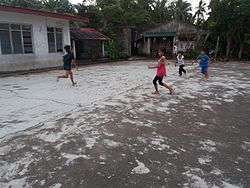Tumbang preso

Tumbang Preso (pronounced as: tum-bahng preh-so) is a traditional Filipino children's game. Tumbang preso is still played by the more active kids today. Even adults sometimes play it too, bringing back memories of their childhood.
This is a very common game among the youth all over the Philippines played in backyards, parks or even in streets with very little vehicular traffic. When the Philippines hosted the World Robot Olympiad in 2010, the game "Tumbang Preso" was played.
The equipment needed are an empty milk can or just simply any kind of can or bottle, and a slipper or a piece of flat stone as a pamato for each player. To make the game enjoyable and exciting, there should be no more than 9 players. One player guards the milk can (the "It") while the others stay behind the toe-line with their pamatos. The object is for the players to hit and knock down the milk can with the pamato, and for the It to put back the can inside a small circle a few meters away from the toe-line. When a player is tagged while recovering his pamato, he becomes the It.
Rules
The rules of tumbang preso are somewhat similar to Duck on a Rock:
- An It, the one to guard the tin can is chosen by throwing the "pamato" to the toe-line by all the players. Whoever's "pamato" is farthest from the toe-line is the It.
- The hitters will get ready at the back of the toe-line and at a signal from the It, game starts.
- The "pamato" must be retrieved immediately once the can is knocked down, the It will start putting it up inside the circle, the one tagged becomes the It.
- When the can is hit and falls outside the circle but remains standing, the It has the right to tag the hitter once the hitter leaves the toe-line.
- The can may be kicked or knocked down under when it is outside the circle.
- If a hitter is not able to retrieve his/her "pamato", the others can save him by hitting the can.
Variation
This variation is played on narrow streets or sidewalks. The same rules apply except for some changes:
- Two toe-lines are used, on opposite sides and are closer to the circle.
- The number of hitters will be divided on opposite sides.
- The milk can may also be flattened a little to make it harder to topple. This can be done by slightly hitting the sides of the can with a blunt object until it folds, then stepping on the can carefully.
- When the hitters run out of pamato, the game turns into a chase. Players on one side will act as bait while those on the other side will try to kick the can, all while trying to avoid being tagged.
- After the can falls down, the game is paused and all pamato is retrieved.
See also
- Traditional games in the Philippines – list of traditional Filipino children's games